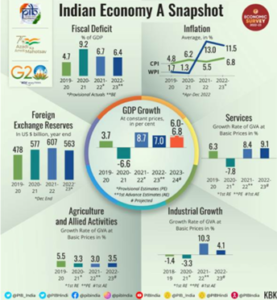The Good and The Sobering.
Economic momentum peak first quarter, Growth is likely to slow down from here.
Relevance
- GS Paper 3
- Government Budgeting.
- Issues related to direct and indirect farm subsidies
- Tags: #GDP #PMI #economy #currentaffairs #upsc
Why in the News?
Quarter 1 economic indicators are released by government.
- The first quarter saw a remarkable surge in economic momentum, with GDP growth reaching 7.8 percent.
- However, beneath this impressive headline figure lie significant challenges and uncertainties that could affect the future course of the economy.
- In this analysis, we delve into the factors driving the current state of the economy and explore the potential hurdles it may face in the coming months.
Strong Indicators Conceal Export Weakness
Q1’s robust GDP growth aligns with leading high frequency indicators.
- The Purchasing Managers Index (PMI) and credit growth data had already signaled rapid growth.
- Despite a notable 6.3 percent drop in exports, the overall growth trajectory remained unscathed.
- Manufacturing performance, however, was somewhat lackluster, despite healthy corporate profits.
Construction boom and government spending
- The construction sector surged by 7.9 percent, driven by government capital expenditure, a boost in real estate activity, and lower input prices.
- Government spending played a pivotal role, growing at an astonishing 59 percent for the central government and 76 percent for major states.
- However, sustaining such high government investments may pose fiscal challenges in the future.
Private Sector Takes the Investment Baton
- Private companies have cleaned up their balance sheets and are poised to increase investments.
- The government’s continued focus on infrastructure development is expected to stimulate private sector participation.
- Capacity utilization in the manufacturing sector is currently above the longterm average, further bolstering private investment prospects.
- Production Linked Incentive (PLI) schemes and the global shift in supply chains present promising opportunities for specific manufacturing sectors.
Challenges and Uncertainties Loom
- Some sectors face demand uncertainties, while public investment is expected to persist.
- Exports, particularly goods exports, encounter challenges from the AsiaPacific region.
- The effects of the Reserve Bank of India’s rate hikes will materialize in the coming months.
- The monsoon’s performance is crucial for agricultural output and rural demand, yet concerns linger due to erratic rainfall patterns.
- In the second half of the fiscal year, economic headwinds from Europe’s slowdown and global geopolitical factors could influence India’s growth prospects.
- Poor merchandise exports performance may impact industrial production.
Future Projections
- Despite potential headwinds, India is poised to maintain its status as the fastest growing G20 economy in the current year.
- GDP growth is anticipated to decelerate to 6 percent in the current fiscal year, down from the previous year’s 7.2 percent.
- The path forward necessitates a balanced approach, combining continued government investment with an expanding role for the private sector.
In conclusion, while the first quarter demonstrated India’s economic vigor, there are significant challenges on the horizon. Prudent management of government investments, active private sector engagement, and the adept handling of external factors will be pivotal in preserving and potentially accelerating economic growth.
| Important keywords
· GDP (Gross Domestic Product): GDP is the total monetary value of all goods and services produced within a country’s borders during a specific time period, typically a quarter or a year. It is a key indicator of an economy’s size and performance. · Purchasing Managers Index (PMI): PMI is a leading economic indicator that measures the health of a country’s manufacturing and services sectors. It is based on surveys of purchasing managers and is used to assess business conditions, with values above 50 indicating expansion and values below 50 indicating contraction. · Government Capital Expenditure (Capex): Government capital expenditure refers to government spending on infrastructure projects, capital assets, and investments that are expected to yield long-term benefits for the economy. · Investment to GDP Ratio: This ratio measures the proportion of total investment in an economy relative to its GDP. It indicates the level of investment activity and its importance in driving economic growth. · Fiscal Consolidation: Fiscal consolidation refers to efforts by the government to reduce its budget deficit and overall debt levels. It often involves measures to increase revenue or reduce expenditure to achieve fiscal sustainability. · Capacity Utilization: Capacity utilization measures the extent to which an industry or sector is using its production capacity. It is expressed as a percentage and indicates the efficiency of production. · Production-Linked Incentive (PLI) Schemes: PLI schemes are government initiatives that offer financial incentives to businesses in specific sectors to promote domestic manufacturing and boost industrial production. · Global Supply Chains: Global supply chains represent the interconnected network of companies and suppliers that collaborate to produce and distribute goods and services on a global scale. · Nominal GDP: Nominal GDP is the total value of goods and services produced in an economy measured in current market prices. It does not adjust for inflation. · Deflation: Deflation is a decrease in the general price level of goods and services in an economy. It is the opposite of inflation and can have various economic implications. · Repo Rate: The repo rate is the rate at which the central bank lends money to commercial banks in exchange for government securities. It is a key tool used by central banks to control monetary policy. · Trade Balance: The trade balance is the difference between the value of a country’s exports and imports. A positive trade balance indicates that a country exports more than it imports, while a negative balance suggests the opposite.
|
Sources:https://pib.gov.in/PressReleasePage.aspx?PRID=1894932
https://epaper.indianexpress.com/3756731/Delhi/September-02-2023#page/1/1
Mains Question
“What are the key factors that contributed to the surge in India’s GDP growth during the first quarter of the fiscal year, and how do these factors impact the future economic outlook?” 250words.




